Western India - geographic region of India
Not to be confused with the West Indies, also known as the Caribbean.
Western India comprises three large states, one small state and one small union territory. It is bounded by Pakistan and the Arabian Sea to its west and the Gangetic Plains to its east. This is the most heterogeneous of India's regions, with the states differing dramatically from one another in language, culture and levels of economic development. Maharashtra and Gujarat are among the most industrialised states of India, while Rajasthan and Goa are magnets for tourists, though for different reasons.
Regions
Western India consists of four states:
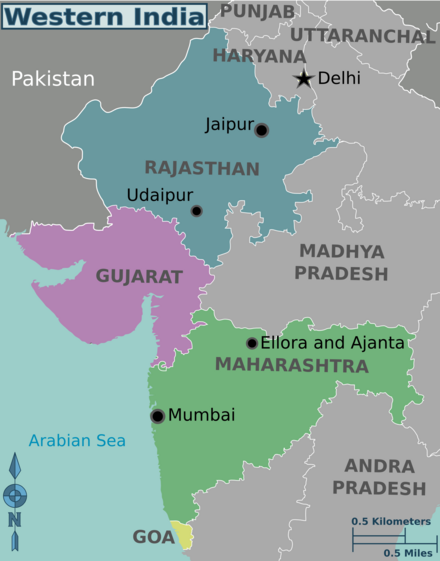
The land of warriors, deserts, colourful saris, historic forts and Rajput temples
Home to Asiatic lions and fine textiles, developing fast especially around Ahmedabad and Surat
India's third-largest state, home to two of its most fascinating cities, Mumbai and Pune
Home to the country's best beaches
There is also a union territory:
- Dadra and Nagar Haveli and Daman and Diu — a group of enclaves, former Portuguese territories, within Gujarat
Cities
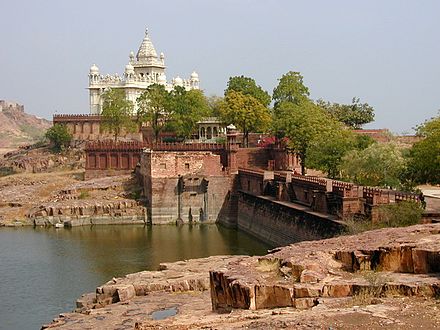

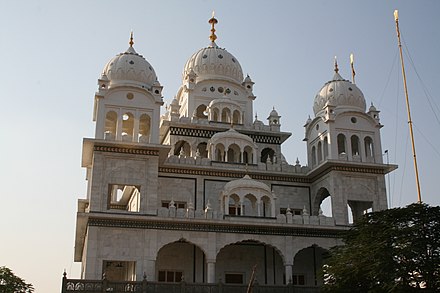
-
Ahmedabad 📍 — the commercial and business capital of Gujarat and one of the fastest developing cities in Asia
-
Aurangabad 📍 (Sambhaji Nagar) — a few miles from the famous Ajanta and Ellora caves, a sacred site for Hindus, Jains and Buddhists
-
Mumbai 📍 (Bombay) — the financial capital, a major port city of India, and the home of Bollywood
-
Panaji 📍 (Panjim) — capital of Goa state, with laidback lifestyle and lots of Portuguese heritage
-
Pune 📍 — Maharashtra's cultural capital, a historic city and home to many educational institutions
-
Pushkar 📍 — home to the country's only Brahma temple; the camel festival in November is an added bonus
Other destinations
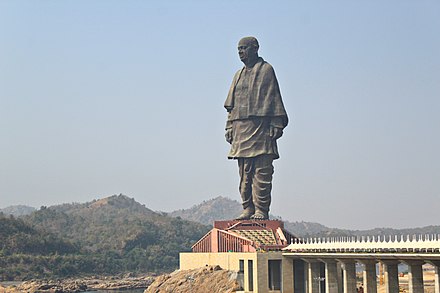
-
Dadra and Nagar Haveli 📍 — an enclave wedged between Gujarat and Maharashtra
-
Diu 📍 — a beautiful island within Saurashtra
-
Kevadia (Ekta Nagar) — a small town best known for the Statue of Unity, the tallest statue in the world
-
Kumbhalgarh 📍 — a gigantic red fort amongst the rugged Arravali Hills, with a wildlife sanctuary nearby
-
Kutch 📍 — largest district of India, Harappan city of Dholavira, a wild ass sanctuary also host of Kutch Mahotsav
-
Matheran 📍 — between Mumbai and Pune, this is Asia's only pedestrian resort
-
Mount Abu 📍 — Rajasthan's only hill station and home to a group of five Jain temples
-
Shekhavati 📍 — comprising Sikar and Jhunjhunu districts, has towns with well-preserved havelis, forts and temples
Understand
This region has some of the country's most popular destinations. In Rajasthan, the desert forts of Jaisalmer and the magnificent sand-dunes evoke all the romance and splendour of its princely past. Gujarat's Jain temples and intricately designed stepwells are architectural marvels, while its natural beauty can be enjoyed on the beaches of Diu.
The landscape in Western India varies from the sand-dunes of Rajasthan to the vast salts of the Kutch, to the urban bustle of Mumbai, Ahmedabad, Surat, etc.
Talk
As in the rest of India, most of the people in the tourist industry speak basic English at the very least. Hindi is widely spoken and understood except in remote rural areas.
Rajasthanis speak regional Rajasthani (and its dialects like Marwari, Mewari, Shekhawati, and Hadoti) as well as Hindi, which is also widely used for media and education. Marathas (people of Maharashtra) speak Marathi, Goans Konkani while people from Gujarat speak Gujarati. English, Gujarati, Hindi and Marathi are spoken in Dadra and Nagar Haveli and Daman and Diu as well.
Get in
 Flying in is convenient, and there are many airports. Railway and sea links exist, but are not recommended for a number of reasons.
Flying in is convenient, and there are many airports. Railway and sea links exist, but are not recommended for a number of reasons.
By plane
By far the most convenient way to enter the region. There are many international airports and Mumbai is the busiest in the country.
International

- Chhatrapati Shivaji Maharaj International Airport in Mumbai is the gateway to India and serves over 40 international carriers. You can fly in from a number of important cities, including Paris, Frankfurt, London, New York, Singapore, Tokyo and Hong Kong.
- Sardar Vallabhbhai Patel International Airport, Ahmedabad from Doha, Kuwait, Dubai, Sharjah, Bangkok and Singapore.
- Pune Airport is quite small and it is a rather inconvenient option for entering India. Nonetheless, it is served by Air India to Singapore and Dubai.
- Jaipur International Airport has limited international flights to the Gulf and Southeast Asia.
- Dr. Babasaheb Ambedkar International Airport, Nagpur is another small international airport.
- Dabolim Airport in Vasco da Gama is Goa's only airport.
Domestic
- Sardar Vallabhbhai Patel International Airport (IATA: AMD): You can reach here from Mumbai, Delhi, Bangalore, Bhopal, Chennai, Goa, Hyderabad, Indore, Jaipur, Kolkata and Pune.
- Surat Airport (IATA: STV): You can reach here from Mumbai and Delhi.
- Civil Airport Harni (IATA: BDQ): You can reach here from Mumbai and Delhi.
- Rajkot Airport (IATA: RAJ): You can reach here from Mumbai.
- Bhavnagar Airport (IATA: BHU): You can reach here from Mumbai.
- Porbandar Airport (IATA: PBD): Only connected to Diu.
- Bhuj Airport (IATA: BHJ): You can reach here from Mumbai.
- Jamnagar Airport (IATA: JGA): You can reach here from Mumbai.
By train
 International options are terribly limited given the length of the Rajasthan-Sindh border. The Thar Express connects Jodhpur, Rajasthan to Karachi in the Pakistan province of Sindh. However, the inconvenience and slow speed of the train do not make this a feasible option. You have to get off at the Attari/Wagah border, pass through security, get your visa stamped and change locomotives. Besides, it's an overnight journey and catching a flight to Pakistan from Mumbai or Delhi is a far better option.
International options are terribly limited given the length of the Rajasthan-Sindh border. The Thar Express connects Jodhpur, Rajasthan to Karachi in the Pakistan province of Sindh. However, the inconvenience and slow speed of the train do not make this a feasible option. You have to get off at the Attari/Wagah border, pass through security, get your visa stamped and change locomotives. Besides, it's an overnight journey and catching a flight to Pakistan from Mumbai or Delhi is a far better option.
Indian Railways (dead link: February 2023) trains connect Western India to many important cities in other parts of the country. Mumbai Churchgate, Victoria Terminus, Ahmedabad, Vadodara, Surat, Pune City, Jaipur and Chhatrapati Sahu Maharaj Terminus are important junctions. The Delhi-Mumbai Rajdhani Express is the fastest train to Western India, connecting the capital to Mumbai in 18 hours. The Trivandrum Rajdhani also passes through Western India and is the fastest way of travelling through some parts of Gujarat.
By boat
Cruises from the Mediterranean ports can be organized and are generally very expensive, amounting to well over €500 one-way. Mumbai is the busiest port in the country. Unless you have a lot of time to spare and a deep pocket, this option is not recommended. There are cheaper boats that ferry passengers from the UAE and Yemen to Mumbai.
Get around
 Getting around generally isn't a problem, as the transportation network is extensive.
Getting around generally isn't a problem, as the transportation network is extensive.
By train
There are good connections available by train. Mumbai is a hub for trains to all major cities. New addition of Konkan rail have picturesque route through Western Ghats.
By road
The national highway network is quite well maintained in Western India. The Mumbai-Delhi leg of the Golden quadrilateral provides excellent connectivity between Maharashtra, Gujarat and Rajasthan. Bus services are very frequent, particularly in Maharashtra and Gujarat. Online booking is possible, and there is no surcharge. They serve cities in Western India including Ahmedabad, Goa, Kolhapur, Mumbai, Nashik, Pune, Shirdi, Surat and Vadodara.
Oneway cab is cab service available in the western region.
By plane
Western India is a large region, so you might want to fly long distances. Even within Western India, flights may well be over an hour long, the Pune-Ahmedabad flight takes one and a half hours. You have to check in an hour and a half in advance. There are numerous airlines serving Western India, for a comprehensive list see India#Get Around. The following airports are used for commercial purposes, there are numerous other small airfields that serve as training centers.
- Maharashtra — Mumbai, Pune, Kolhapur, Nashik, Aurangabad and Nagpur
- Gujarat — Vadodara, Ahmedabad, Rajkot,Surat, Jamnagar, Porbandar, Bhuj, Bhavnagar and Diu
- Goa — Vasco da Gama

- Rajasthan — Jaipur, Jodhpur, Udaipur and Jaisalmer
See
There is plenty to see in Western India, which makes it a particularly touristy area.
Forts and palaces
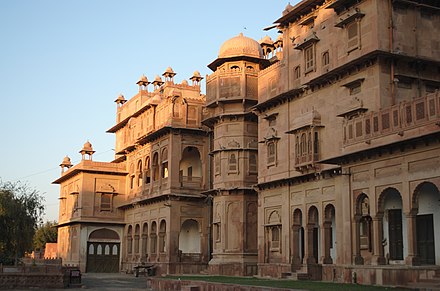 The spectacular forts of Rajasthan were built as unforgiving defensive citadels, but by the mid-16th century luxurious palaces, pleasure pavilions and gardens were added, displaying Mughal-inspired features. In the early 20th century there was another spate of palace building in Rajasthan and Gujarat. As a result of increasing contact with the British Raj, a marked European influence in both architecture and décor is clearly visible in these palaces.
The spectacular forts of Rajasthan were built as unforgiving defensive citadels, but by the mid-16th century luxurious palaces, pleasure pavilions and gardens were added, displaying Mughal-inspired features. In the early 20th century there was another spate of palace building in Rajasthan and Gujarat. As a result of increasing contact with the British Raj, a marked European influence in both architecture and décor is clearly visible in these palaces.
Hill forts such as the ones in Chittorgarh and Jodhpur are the most impregnable examples of Rajasthani forts. The forts at Jaisalmer, on the other hand, lie amidst the sand-dunes of the Thar Desert. Bharatpur's Lohagarh fort used thick mud walls for protection. The Neemrana fort Palace, now a hotel is another architectural wonder with brilliantly designed balconies and lush green patches.
Lalgarh Palace in Bikaner was built in 1902 and is a wonderful example of Indo-European architecture. The unique blend of both styles in reflected in the banquet halls and old-fashioned billiard rooms. The Wankaner Palace is crowned with Italianate pillars and Gothic arches. The cities of Jaipur and Udaipur have the best palaces.
Wildlife
Western region of India has variety of geography ranging from deserts of Rajasthan and Kutch-Gujarat to long coast of Gujarat, Maharastra and Goa. There are some of the oldest forest of western ghats and grass lands in Saurashtra-Gujarat and part of Maharastra.
 Sariska National Park and Ranthambore National Park are both home to tigers. However, the chances of spotting them are low (especially at Sariska since there are barely a handful left), unless you decide to spend a week or more at these places. The Keoladeo Bird Sanctuary on the outskirts of Bharatpur is a UNESCO World Heritage Site and is home to over 275 species of migrant birds. Don't expect miles and miles of forest green in these sanctuaries, most of the landscape is dry and slightly rocky scrubland.
Gir Forest National Park in Gujarat is only place where you can find Asiatic Lions and their population is on the rise. Some other attractions for wildlife enthusiasts are Blackbuck National Park, Nalsarovar Bird Sanctuary, Wild Ass National Park in Kutch, Koyna Wildlife Sanctuary. There are many wildlife sanctuaries where approved campsites are available. Facilities at these campsites can vary widely and lesser known sanctuaries have very basic camping facilities.
Sariska National Park and Ranthambore National Park are both home to tigers. However, the chances of spotting them are low (especially at Sariska since there are barely a handful left), unless you decide to spend a week or more at these places. The Keoladeo Bird Sanctuary on the outskirts of Bharatpur is a UNESCO World Heritage Site and is home to over 275 species of migrant birds. Don't expect miles and miles of forest green in these sanctuaries, most of the landscape is dry and slightly rocky scrubland.
Gir Forest National Park in Gujarat is only place where you can find Asiatic Lions and their population is on the rise. Some other attractions for wildlife enthusiasts are Blackbuck National Park, Nalsarovar Bird Sanctuary, Wild Ass National Park in Kutch, Koyna Wildlife Sanctuary. There are many wildlife sanctuaries where approved campsites are available. Facilities at these campsites can vary widely and lesser known sanctuaries have very basic camping facilities.
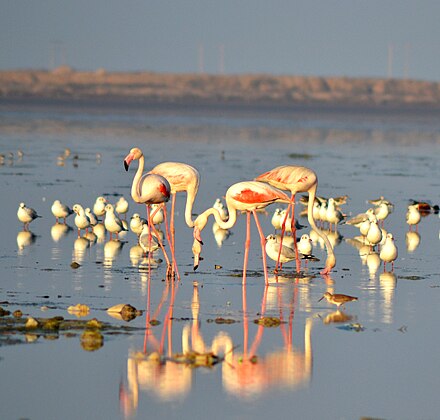
Museums
Mumbai, Jaipur and Pune house a number of good museums. See the city pages for more information. The Prince of Wales Museum and the National War Museum perhaps the most well-known.
Eat
You will find some great cuisine groups in the region. Gujarati cuisine is mostly vegetarian, sweet, and makes heavy use of milk products. Gujaratis make some of the best snack items such as the Dhokla and the Muthia. Rajasthani cuisine is similar to Gujarati, but somewhat spicier. Maharashtra and Goa are famous for their seafood.
Thalis
If you order a thali (lit: "platter"), you will get a complete meal arranged on your plate, with a roti or chappati, rice and many different varieties of curries and curd. Ordering a thali is a popular option when you are hungry and in a hurry as it will usually be served blazingly fast. Most mid-level restaurants will have a thali on the menu, at least during lunch hours. Occasionally, they will be "unlimited", which means that some of the items are all-you-can-eat. The waiters will actually serve them at your table. Try the Gujarati thali, with its unlimited range of vegetarian dishes, or the spicier Rajasthani thali. The Rajdhani chain of retsurants serve the best thalis for a mere ₹124. They have numerous locations throughout Mumbai, Vadodara and Pune.
Drink
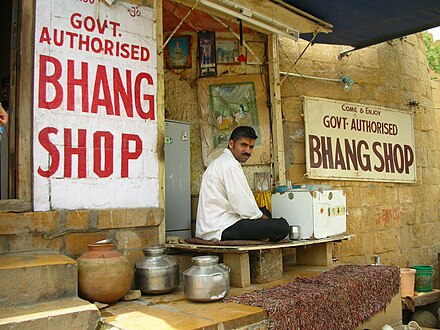 This is a region with drastically different approaches to alcohol! Gujarat is a dry state, which means that you cannot legally purchase alcohol without a special permit. Dadra and Nagar Haveli and Daman and Diu, a union territory directly administered by the central government, has taken full advantage of Gujarat's prohibition by setting extremely low taxes on alcohol and as a result is a popular destination for Gujarati alcohol tourism. Goa has an extremely liberal attitude to drinking and feni, a wine made of cashew is a popular drink there. Maharashtra is fast becoming a wine-producing region and the Sula wines are beginning to make a mark internationally.
This is a region with drastically different approaches to alcohol! Gujarat is a dry state, which means that you cannot legally purchase alcohol without a special permit. Dadra and Nagar Haveli and Daman and Diu, a union territory directly administered by the central government, has taken full advantage of Gujarat's prohibition by setting extremely low taxes on alcohol and as a result is a popular destination for Gujarati alcohol tourism. Goa has an extremely liberal attitude to drinking and feni, a wine made of cashew is a popular drink there. Maharashtra is fast becoming a wine-producing region and the Sula wines are beginning to make a mark internationally.
Bhang, a form of cannabis is available at government-recognized shops and is socially accepted in Rajasthan.
Cafe Coffee Day (dead link: January 2023) and Barista have coffee stores in Mumbai, Pune, Vadodara, Ahmedabad, Gandhinagar, Rajkot, Jamnagar, Nashik, Jaipur, Jodhpur, Jaisalmer, Udaipur and Surat. Fresh juice is available off the sidewalk for nominal prices, usually ₹15-₹20 a glass.
This region has tea-loving culture. Any time is good for offering tea. Tea here comes with milk (cream) and sugar unless you specify otherwise.
Stay safe
Unlike the plains, Western India has a low crime-rate. Pickpockets are known to operate in Pune and Mumbai. Keep your money, passport and credit card safely in your wallet. The National Toll-free Police Helpline is 100.
Rajasthan has plenty of persistent touts. Just ignore them and walk on. Hotel scams are not uncommon and booking a room in advance is highly recommended.